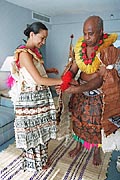By Paula Rath
Advertiser Island Style Writer
A model wafts down the runway in a graceful, flowing ivory bridal gown of silk and lace. Then follows an elegant traditional white holoku. Next is a sophisticated brown and beige ensemble of masi. Masi?
 |
| The bride’s top, called sulu masi, is tied at the back. Styling of the tie is reminiscent of the Japanese obi, creating the appearance of a blossoming flower or butterfly. Fijian brides do not carry bouquets. The finishing touch is a pair of wristlets made of dyed wild hibiscus fibers.
Eugene Tanner • The Honolulu Advertiser |
Masi is the Fijian version of kapa or bark cloth. At the Hawai‘i Bridal Expo Fashion Show on Friday, traditional Western and Island style bridal models will be joined by a model in wedding attire seldom seen in Hawai‘i: the Fijian masi ceremonial dress.
Masi — the word refers both to bark cloth and to the paper mulberry tree itself, known in Hawaiian as wauke — is synonymous with wealth in Fiji. The more rolls a family owns, the wealthier they are considered to be.
In the case of a wedding ensemble, the more layers of masi worn by the bride and groom, the wealthier the family.
A train of masi is also sometimes worn by the groom. The length of the train, which can be hundreds of yards long, also denotes wealth.
As with Hawaiian kapa, masi is made from the bark of the paper mulberry tree. When the trees reach maturity, after one year, they are cut down and the bark is stripped away, then soaked in water. The pieces of bark are later scraped with a blunt-edged shell to remove the rough outer surface.
Once the bark is ready, it is laid on a convex curved table or thick piece of timber and beaten with wooden anvils into a fine paper cloth. Strips are pounded together to achieve the desired width and length.
When completed, masi is stiffer than Hawaiian kapa (which was known as the finest textured of the kapas); for this reason, Fijian masa drapes differently than the Hawaiian product.
The wedding dress that will be featured in the fashion show was made in the village of Lomanikaya on Vatulele Island. It consists of two masi pieces for the skirt, one 6 feet by 4 feet and the other 8 feet by 4 feet. The top is a long strip, about 2 feet by 10 feet.
Masi’s natural hue is off-white. Printed masi is called masi kesa and the masi used in dresses usually are printed.
Designs are derived from natural dyes. To achieve dark brown, kukui nut or mangrove sap is pounded and boiled. For pale reddish brown, red clay soil is used. Black, which denotes chiefdom, is made of soot collected from the roofs and shelves of homes, mixed with coconut oil.
To create textile designs, stencils are cut out of banana leaves. Unlike Hawaiian kapa, which usually tells a story or traces a genealogy, Fijian masi patterns simply represent the islands from which they came.
Masi is currently being made on all the islands of Fiji.
Emosi Damuni, who is from Vitilevu, Fiji, came to the Islands in 1964 to build the Fijian village in the Polynesian Cultural Center.
Said Damuni: "When I was growing up I didn’t see as much of it (masi) being made as I see now."
The cost of a masi wedding outfit is $40-$75 U.S. dollars. You can’t actually buy such an outfit here but you might be able to locate the masi and have someone from Fiji pleat it for you.
Masi used to always be passed down from generation to generation. Now the custom varies from village to village; in some, it gets passed down and in others each couple owns their own masi because there’s so much being made now that it’s not quite as rare and valuable.
It’s very uncommon for the Fijian wedding dress to be used here in Hawai‘i, though Emosi Damuni’s son and his bride did wear traditional garb for their wedding.
The resurgence in masi-making means that masi is now widely used in interior design — for bedspreads, wall coverings, placemats and partitions. At the Outrigger Reef Fiji hotel, 4,000 meters of masi decorate the ceilings of the bures (cottages where guests stay).
Masi’s use is not limited to weddings; it is present at most ceremonies, including funerals, births and the arrival of a chief.
[back to top] |

 The Great Index to Fun
The Great Index to Fun